Sai 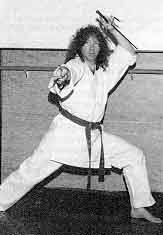
Okinawa was basically a poor farming and fishing country that was never able to support a warrior class or afford the weapons of that class. The sai is probably based on a Chinese implement that was used for digging furrows in the ground for planting seeds. It was used by the police in Okinawa in much the same fashion as the modified baton is used by Canadian police forces.
As the bo became the dominant weapon, other weapons were invented to
counter it. These were often used in pairs to give the person the ability
to counter and attack at the same time, taking away the advantage that
the bo has in reach. Sai were not indigenous to the Ryukyu Islands. They
were probably imported from China via the Fukien trade route. When the
occupying army officials looked for arms, they did not seem like weapons
among farming and fishing tools. The sai is probably based on a Chinese
implement that was used for digging furrows in the ground for planting
seeds. It was used by the police in Okinawa in much the same fashion as
the modified baton is used by Canadian police forces. 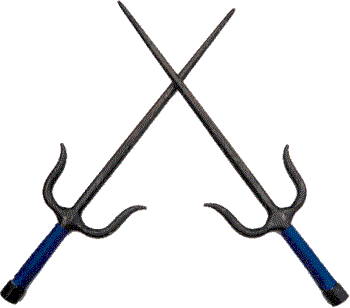
The weapon itself has many names and is common throughout the Far East. The sai may have been introduced to Okinawa as weapons of Chinese martial arts, then later taken and adapted by the Ryukyu styles. The peasants probably used the sai to defend themselves, their property, or their families from marauding bandits and pirates. Kata were eventually developed to define the use of each "weapon."
Multi-purpose instruments like the sai became especially useful, since
an opponent's weapon could be blocked and/or trapped with one sai, disarming
the attacker with the option of delivering a thrust with the pointed tip
of the main shaft, which is used to puncture a target. 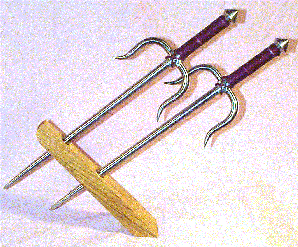
Customarily fifteen to twenty-one-and-a-half inches in length, and a diameter tapered from 5/8", the modern sai consists of an octagonal or round rod leading to a pointed end that is flanked on either side by two shorter tines or forks. An early version of the sai had only one prong, and consisted of a flat metal handle with a bamboo hilt held together with cord.
Many years ago, the sai was made according to a practitioner's personal
standards, and different shapes and styles were produced. One variation
of the sai is the nunti, which has one of the outer prongs pointing in
the opposite direction, toward the handle, and is often attached to the
end of a bo (the nunti-bo), one of the few pole weapons of Okinawa. 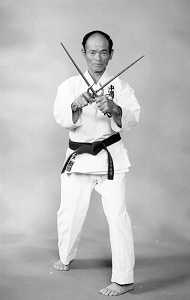
A sai is of the proper length for the student if it extends approximately one inch past the elbow. Balance is also an important consideration in choosing or purchasing a weapon, which can be tested by placing the forefinger under the shaft where the two prongs meet. If the sai is properly balanced, the weapon should remain in place and not tilt to either side.
The quality of the metal can be discovered by taking a sai in each hand with a natural grip (honte-mochi) and tapping them together. A ringing resonance should be heard, rather than a dull sound. Sais can range in price from $29 (although I did see a place selling sai with cosmetic imperfections in the chrome for $10) to close to $400 for sai made from A36 stainless steel.
The mass produced sai are drop forged (essentially poured) while the
better quality sai are individually hand forged, making them much stronger
but, ironically, with a much rougher, less polished look. Chrome plating
or raw metal is another consideration when selecting a modern sai, which
is blunted at the end to be used in demonstrations and kumite drills.
Chrome plating looks impressive in demonstrations with its bright shine,
but could prove ineffective in actual use, as the finish may allow a trapped
weapon to slip out of the hold. Raw metal is the best choice, as it will
not chip or dent, and plant oil can be applied to all parts (except the
handle) to prevent rusting. Chrome sai should be rubbed down with a cloth
after each training session. 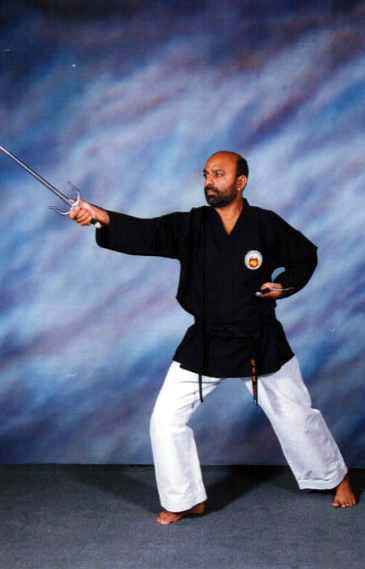
The typical design of the sai indicate that it would not stand up to the katana. It was made of too poor a grade of iron, and the short arms are too widely spaced to effectively trap a sword. On the other hand, they are idea for trapping a bo, or an arm. As well as striking, trapping, and piercing, the sai could be used for pinning the opponent by sticking them to the ground. Often 3 sai were carried, one being in the belt so that one could be thrown-typically downward to fix the opponent's foot to the ground-while still leaving 2 sai for use. Also, if you stabbed someone in the chest or leg, the suction as you tried to pull it out would delay you long enough to be in danger.
All in all the sai is probably the second most used kobudo weapon. Nunchuks are very popular but illegal in many places. You seldom see sai in competition. Weighing in at 3 pounds a pair, the weight of the weapon mitigates against the flash so popular in modern tournaments.